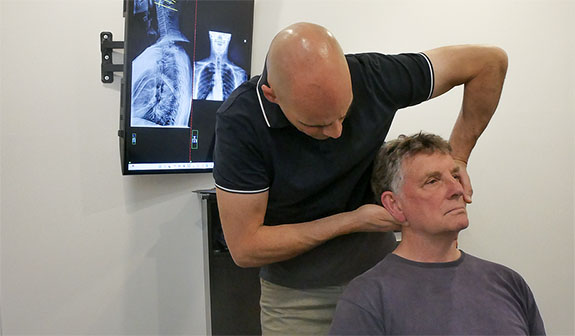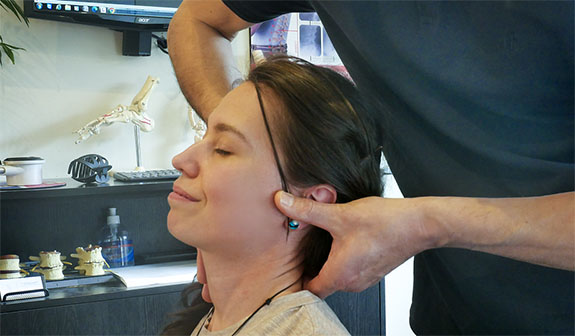Premier Melbourne Chiropractors
✓ Onsite Parking ✓ Wheelchair Access ✓ X-Ray - 424 Blackburn Rd, Glen Waverley VIC 3150
✓ Onsite Parking ✓ Wheelchair Access ✓ X-Ray
424 Blackburn Rd, Glen Waverley
Head Pain Conditions
We Pinpoint Specific Symptoms, Differentiate Types Of Head Pain For Effective Diagnoses And Treatments.
Understanding The Types Of Head Pain Conditions Our Chiropractors Treat
Our Chiropractors treat a variety of head pain conditions, focusing on those related to musculoskeletal issues. Commonly treated types include tension headaches - usually caused by muscle tension around the head and neck, migraines - characterised by severe, throbbing pain typically on one side of the head and may be accompanied by nausea, vomiting, or sensitivity to light, cervicogenic headaches - which originate from neck problems, TMJ disorders - jaw pain issues and vertigo - sudden dizziness, all are within the chiropractic scope of care.
If you are suffering from any type of head pain issue, we help individuals discover the cause and formulate effective, non-invasive solutions tailored to their specific needs, ultimately leading to long-term relief and improved quality of life.
BPPV is a disorder arising from a problem in the inner ear. It is one of the most common causes of vertigo, characterised by sudden episodes of dizziness and a sensation of spinning with changes in the position of the head. These episodes are usually brief but can significantly disrupt daily activities. BPPV occurs when tiny calcium carbonate crystals, known as otoconia, dislodge from their usual location and move into one of the ear canals. This movement interferes with the normal fluid dynamics of the ear, leading to vertigo. While BPPV can affect individuals of any age, it is more prevalent among older adults. The condition is generally non-serious and often responds well to a series of specific head and body movements known as the Epley manoeuvre, which helps relocate the displaced crystals, alleviating symptoms.

Vertigo Cause
BPPV can be triggered by certain activities such as rolling over in bed, tilting the head back, or looking up. It may also occur without any apparent cause. In addition to dizziness and spinning sensations, individuals with BPPV may experience nausea, balance problems, and difficulty focusing their eyes. These symptoms can greatly impact one's quality of life and may even lead to anxiety or fear of falling. While the exact cause of BPPV is not fully understood, there are certain risk factors that may increase its likelihood. These include a history of head trauma, ear infections, migraines, and conditions affecting the inner ear such as Meniere's disease. Women are also more prone to developing BPPV than men.
Benign Paroxysmal Positional Vertigo (BPPV)
Vestibular disorders encompass a variety of conditions that affect the inner ear and brain areas that control balance and eye movements. Other significant vestibular disorders include Ménière's disease, vestibular neuritis, and labyrinthitis.
Ménière's disease is characterised by episodes of vertigo, tinnitus, hearing loss, and a feeling of fullness in the ear, stemming from fluid imbalance.
Vestibular neuritis, typically triggered by a viral infection, causes inflammation of the vestibular nerve and results in vertigo, imbalance and nausea.
Labyrinthitis, another inflammation-related disorder, affects both the cochlear and vestibular nerves, leading to hearing loss and vertigo.
Each disorder can significantly impact daily life, making accurate diagnosis and effective management essential for improving patients' quality of life.
They can occur at any age and can be caused by a variety of factors such as genetic predisposition, head trauma, inner ear infections, or certain medications. Diagnosing vestibular disorders can be challenging due to the wide range of symptoms and underlying causes. This is why a thorough evaluation by our trained Doctors is necessary to determine the specific type and cause of the disorder.
Because of the variation of conditions, treatment for vestibular disorders is always dependent on the individual's specific situation. Vestibular rehabilitation therapy is often recommended to improve balance and reduce symptoms such as dizziness and vertigo. This specialised form of physical therapy focuses on retraining the brain to compensate for any deficits in the vestibular system.
In addition to medical treatment, lifestyle changes can also play a crucial role in managing vestibular disorders. These may include avoiding triggers such as sudden head movements, getting enough rest and reducing stress levels, and incorporating relaxation techniques into daily routines. If you’re suffering from any of the above symptoms, be sure to arrange an appointment with one of our Doctors at your convenience.
Other Vestibular Disorders
Facial nerve pain, medically referred to as Trigeminal Neuralgia, is a chronic condition characterised by episodes of intense, shooting pain in the face. This pain stems from the trigeminal nerve, which is responsible for transmitting sensations from the face to the brain. The condition can be triggered by everyday actions such as brushing teeth, eating, or even exposure to wind. It is often unpredictable and can vary in intensity, presenting challenges in both diagnosis and management.
Causes of Trigeminal Neuralgia
The exact cause of Trigeminal Neuralgia is unknown, but it has been linked to a variety of factors. One possible cause is pressure on the trigeminal nerve such as from a blood vessel. In some cases, multiple sclerosis and other diseases that damage the protective myelin sheath around the nerve can also lead to facial pain. Other potential causes include injury to the face or head, such as from a fall or car accident, and certain medical conditions like diabetes or high blood pressure. Some researchers suggest that genetics may also play a role in developing Trigeminal Neuralgia.
While the exact cause remains unclear, it is believed that the trigeminal nerve becomes irritated or damaged, leading to the characteristic shooting pain.
Symptoms of Trigeminal Neuralgia
The primary symptom of Trigeminal Neuralgia is brief, intense episodes of facial pain. These episodes can last for a few seconds to a few minutes and may occur multiple times per day. The pain is often described as stabbing or electric shock-like and can be triggered by everyday activities like chewing, talking, or touching the face. Additionally, some people with Trigeminal Neuralgia may experience a constant dull ache in between episodes of intense pain. This lingering discomfort can affect daily activities and contribute to overall frustration and decreased quality of life.
Diagnosis
Diagnosing Trigeminal Neuralgia can be challenging as the symptoms may overlap with other conditions, such as dental problems or sinus issues. We conduct a thorough medical history and physical exam to clarify the likely diagnosis of facial nerve pain. In some cases, a neurological exam may also be performed to assess the function of the trigeminal nerve and determine if it is being compressed or damaged in any way.
Facial Nerve Pain (Trigeminal Neuralgia)
Temporomandibular Joint Dysfunction (TMJ) refers to a variety of conditions that affect the temporomandibular joint, which connects the jaw to the skull. This dysfunction can lead to pain and discomfort both in the joint itself and in the muscles controlling jaw movement. Symptoms often include jaw pain, difficulty chewing, a clicking or locking jaw, and even headaches. The causes of TMJ can vary widely, including injury, arthritis, or habitual clenching of the teeth. Early diagnosis and management can help alleviate symptoms and prevent further complications.
Some common causes of TMJ dysfunction include:
Injury or trauma to the jaw joint: This can cause damage to the joint and surrounding muscles, leading to pain and discomfort.
Arthritis: TMJ arthritis is a type of inflammatory arthritis that affects the temporomandibular joint, causing difficulty opening and closing the mouth.
Bruxism (teeth grinding): Habitual clenching or grinding of the teeth can put excessive pressure on the jaw joint, leading to TMJ dysfunction over time.
Misaligned bite: A misalignment of the teeth or jaw can also contribute to TMJ dysfunction as it puts strain on the joint during chewing and speaking.
Stress: Tension in the muscles of the jaw due to stress or anxiety can also contribute to TMJ dysfunction.
It is important to note that while these are some common causes, every individual may experience TMJ dysfunction differently.
Temporomandibular Joint Dysfunction
Migraines are a type of severe headache characterised by intense throbbing or pulsing sensations, often on one side of the head. They can be accompanied by nausea, vomiting, and extreme sensitivity to light and sound, significantly affecting daily life. The exact cause of migraines is not fully understood, but they are believed to involve a combination of genetic, environmental, and neurological factors. Triggers can vary widely among individuals, including stress, certain foods, hormonal changes, and even weather conditions. Treatments for migraines typically include a combination of lifestyle adjustments, medication to manage symptoms, and preventive strategies to reduce the frequency and severity of attacks. In this section, we will delve deeper into the causes and triggers of migraines, as well as effective treatment options.
Causes of Migraines
The exact cause of migraines is not fully understood, but there are several factors that are believed to contribute to their development. These include:
Genetic Predisposition: Research shows that genetics play a role in migraine susceptibility. If one or both of your parents have a history of migraines, you may be more likely to develop them as well.
Environmental Factors: Exposure to certain environmental triggers can also increase your risk for migraines. These can include changes in weather patterns, bright lights, loud noises, strong smells, and even secondhand smoke.
Neurological Abnormalities: Migraines are thought to be caused by changes in brain activity, specifically involving the trigeminal nerve, a major pain pathway. These changes can lead to inflammation and overstimulation of blood vessels in the brain, resulting in intense headaches.
Hormonal Changes: Fluctuations in estrogen levels have been linked to migraines in women. Many women experience migraines during their menstrual cycle or when taking hormonal birth control.
Triggers of Migraines
While each individual may have unique triggers for their migraines, there are some common factors that can increase the likelihood of an attack.
These include:
Certain Foods: Some foods and beverages are known to trigger migraines in some individuals. These may include aged cheeses, processed meats, alcohol, and caffeinated drinks.
Changes in Routine: Not enough sleep or changing your eating habits can disrupt your body's natural rhythm and increase your risk for migraines.
Hormonal Fluctuations: As mentioned earlier, changes in hormone levels can trigger migraines in women.
Environmental Triggers: Exposure to bright lights, loud noises, strong smells, and other environmental factors can also lead to a migraine attack.
Migraine Treatment
Chiropractic care has become a recognised, non-invasive approach for managing migraines, especially for individuals seeking alternatives to medication. We address migraines by focusing on the alignment and health of the spine, particularly the cervical (neck) region, which is closely connected to the nervous system and blood flow to the brain. By reducing physical stressors and enhancing spinal function, chiropractic treatment can help reduce the frequency, severity, and duration of migraines for many patients.
Migraines
Fortunately, BPPV is highly treatable and usually resolves within a few weeks or months. In addition to the Epley manoeuvre, other exercises and lifestyle modifications may help alleviate symptoms and prevent recurrence. These include avoiding sudden head movements, using caution when changing positions, and incorporating balance exercises into daily routines.
In some cases, BPPV may become chronic or recur despite treatment. This can be due to multiple factors such as underlying ear damage or the presence of multiple displaced crystals. In such cases, further evaluation and additional treatments such as surgery or medication may be necessary.
Overall, while BPPV can significantly disrupt one's life, it is a manageable condition with effective treatments available. Early recognition and proper management can greatly improve symptoms and quality of life for individuals living with BPPV. If you experience recurring episodes of dizziness or spinning sensations, contact us for professional diagnosis and treatment.
Vertigo Treatment
Types of Headaches
Cluster Headaches: Recurring headaches that come in cyclical "clusters," characterised by intense pain around one eye or one side of the head.
Post-Traumatic Headaches: Headaches that develop after a head injury, which can be persistent and worsen with exertion.
Sinus Headaches: Caused by inflamed sinuses, often accompanied by sinus symptoms like nasal congestion, facial pain, and pressure.
Hormonal Headaches: Related to hormonal changes, such as during menstrual cycles, pregnancy, or menopause, resulting in migraine-like symptoms.
Rebound Headaches: Caused by the regular, long-term use of medications to manage headaches, leading to a cycle of chronic headache.
Nerve-Related Headaches: Originate from nerve irritation or compression, like occipital neuralgia, manifesting as pain at the back of the head and neck.
Read more about Nerve Pain Conditions.
Stress-Induced Headaches: Often tension-type headaches resulting from stress, anxiety, or fatigue, typically presenting as a dull, aching sensation.
Eye Strain Headaches: Result from prolonged eye activity such as staring at screens, causing discomfort and headache symptoms.
Hypertension Headaches: Related to high blood pressure, generally severe at the back of the head, accompanied by other symptoms like chest pain.
Dehydration Headaches: Occur when the body is dehydrated, leading to diminished fluid and electrolyte balance, which impacts brain function.
Chronic Daily Headaches: Frequent headaches that occur 15 or more days a month over several months, often transforming from episodic headaches.
Tension Headaches: The most common type, often related to stress or tension, characterised by a pressing or tightening sensation.
Cervicogenic Headaches: Headaches derived from neck problems, often presenting with pain that starts in the neck and spreads to the head.
Read more about Neck Pain Conditions.
Headaches vary greatly in type and severity, and understanding the specific type and cause is crucial to effective management. While many headaches can be managed with lifestyle changes and over-the-counter medications, more persistent or severe headaches may require professional treatment. With proper diagnosis and treatment, most people can find relief from headaches and maintain a good quality of life.
Headache Treatment with Chiropractic Care
Chiropractic care has become a valuable option for headache treatment, particularly for those suffering from tension headaches and migraines. Our chiropractors focus on treating musculoskeletal issues that contribute to headaches, especially issues with alignment, posture, and muscle tension in the neck, shoulders, and spine. Chiropractic treatment is non-invasive, drug-free, and focuses on addressing underlying causes of headache pain rather than merely masking symptoms. For those experiencing chronic or severe headaches that impact quality of life seeking relief can contact us and book an appointment anytime.
For anyone experiencing any of these symptoms or if you suspect one of the above conditions, our Doctors are highly experienced and provide professional, specialised analysis and service.
Headaches are one of the most common ailments affecting people of all ages. They vary widely in cause, intensity, location, and duration, with types ranging from mild tension headaches to severe, debilitating migraines. Headaches can arise from a range of factors, including stress, dehydration, certain foods, or underlying health conditions. While often harmless, chronic or severe headaches may significantly impact quality of life and require a more targeted approach to management. Addressing underlying medical conditions can be vital in managing chronic headaches. Conditions such as sinus issues or hormonal imbalances may require medical evaluation and treatment. It is important to speak with a healthcare professional if you experience frequent or severe headaches to identify any underlying causes.

Headache At The Top Or Back Of The Head
Headaches located at the back of the head or the top can be discomforting and may vary in intensity and duration. Common causes for such headaches include tension headaches, which are often triggered by stress, poor posture, or muscle strain. These headaches typically produce a dull, aching sensation and can be associated with tightness in the neck or scalp. Another potential cause is occipital neuralgia, a condition where nerves running from the top of the spinal cord to the scalp become inflamed or injured, leading to sharp, shooting pains. Understanding the underlying causes of these headaches helps in devising effective treatment plans, and that’s exactly what our experienced headache Chiropractors do.
Headaches

Have a question about head pain Chiropractic care?
